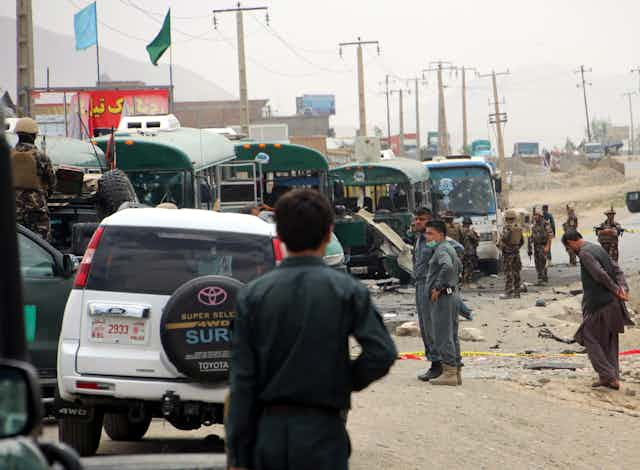The Afghan capital, Kabul, recently saw its deadliest terror attack in some time, as a suicide bomber detonated a device in the middle of a peaceful street protest. Some 80 people were killed and hundreds more wounded.
The so-called Islamic State (IS) promptly claimed responsibility for the bombing, while a spokesman for the Afghan Taliban made it clear that his group had nothing to do with the attack. Both IS and the Taliban use their media organs to disseminate propaganda in support of their separate Afghan campaigns, but for once, both claims appeared plausible, and it seems that IS really is the culprit.
The bombing has again focused attention on the threat IS poses to Afghanistan – and once again raises the question of how the country’s various jihadist groups relate to each other.
IS’s Afghan arm is a fringe militant group in the sense that it accounts for a relatively small percentage of the fighters in the country who are waging violent jihad against the state. At the peak of its military strength, it claimed to have around 5,000 men under arms. Over the past year, it’s contended with military pressure from NATO and Afghan government forces and, separately, from the Afghan Taliban, to which several hundred of its fighters have recently defected.
At the national level, IS fighters in Afghanistan probably amount to less than 10% of the number affiliated to the Taliban’s Islamic Emirate.
Nonetheless, as the Kabul attack showed, it cannot be dismissed as inconsequential. Over the past two years, it has carved itself a particular niche on the local jihadi scene. And that the claim of responsibility for Saturday’s attack came through Amaq, IS’s news agency, is a reminder of the “official” status that IS-aligned fighters in Afghanistan enjoy.
Life on the edge
In IS terminology, its forces in Afghanistan are known as the Khorasan Province. The ranks are made up of dissidents, extremists and defectors who have been squeezed out of the more established jihadi organisations and include Pakistanis, Afghans and assorted international militants. Its ameer, Hafiz Saeed Khan, hails from Pakistan’s tribal territory of Orakzai; he previously served as a particularly ruthless commander under Pakistani Taliban (TTP) leader Hakeemullah Masood, and has a track record of attacks on civilian targets and mosques.
As the TTP fell into disarray after Hakeemullah was killed in a drone strike, Saeed led a contingent of his Orakzai and Afridi tribal comrades into the Khorasan Province. Abdul Raheem Muslim Dost, an Afghan veteran of the US’s detention facility at Guantanamo Bay and one of the few figures to have cultivated an image as an intellectual, also joined Khorasan Province – but he recently parted company with the group once again, publicly rejecting its policy of targeting civilians.
The leadership of the Afghan Taliban, for its part, has long been wary of IS’s violent Salafist ideological influence. It has tried to stay close to Sunni Islam’s Hanafi school, the majority sect in Afghanistan. This is why now-dead Afghan Taliban veteran Rauf Khadim who had been purged by the Taliban leadership for his Salafist beliefs, ended up as the Khorasan Province’s first deputy.
Similarly, the Khorasan Province has attracted contingents of Uzbek, Azerbaijani and Arab fighters. These are militants from groups that were once affiliated with al-Qaeda, and which were part of the jihadi scene in the violent province of Waziristan before the Pakistani Armed Forces launched their anti-extremist Zarb-e-Azb military operation there.

In effect, Khorasan Province provides a home for militants who want to participate in the jihad, but who are unwilling to accept the authority of the Afghan or Pakistani Taliban or al-Qaeda. Its foreign recruits tend to subscribe to the most extreme version of takfiri ideology and embrace the most violent of tactics; they have deep differences even with the al-Qaeda leadership. And whereas the Afghan Taliban has deliberately kept open channels of communication to Afghan Shias, the kind of militants who signed up for Khorasan province would have been all too happy to target Kabul’s Shia civilians.
Brothers in arms
The key to Khorasan Province’s survival has been Afghanistan’s abundance of ungoverned space. The rural areas of border provinces, such as Nangarhar, Kunar and Nuristan, have been cut off from government control by the Afghan Taliban’s decade-and-a-half-long insurgency, which has systematically rolled back the state’s writ across much of the countryside.
As a result, Khorasan Province’s loose collection of dissident jihadists have been able to establish training camps, recruit new fighters from among the locals, and extract revenue from mineral resources and smuggling routes.
The Taliban’s campaign has also disseminated the technology of conflict widely, training scores of Afghans and Pakistanis to be “engineers” who can fabricate improvised explosive devices and suicide jackets. To supply the Afghan Taliban, tribal entrepreneurs have developed a sophisticated market along the Pakistan-Afghan frontier for every kind of weapon the modern guerrilla could want.
And while the Afghan Taliban and al-Qaeda leadership are strongly opposed to the Khorasan Province, many of the three groups’ fighters are old comrades still prepared to help each other out, whether it’s supplying their colleagues with scarce military materials or interceding with local authorities to get them out of trouble.
The Khorasan Province’s ability to carry out attacks such as the recent one in Kabul is thus a by-product of the Afghan Taliban’s success. That means that all efforts by the Afghan government or NATO to single out the fighters of Khorasan Province as targets, or even to disrupt the movement’s extremist recruitment, are unlikely to achieve much. The more fundamental challenge is to bring Afghanistan’s ungoverned spaces, and the Taliban insurgency which created them, under control once again.

